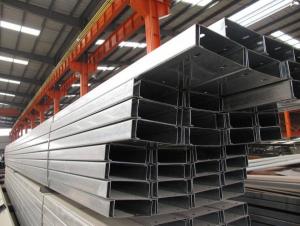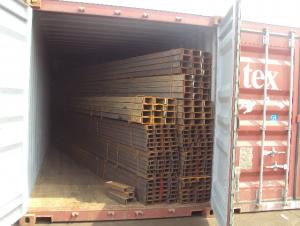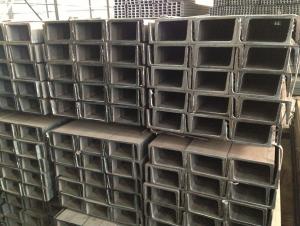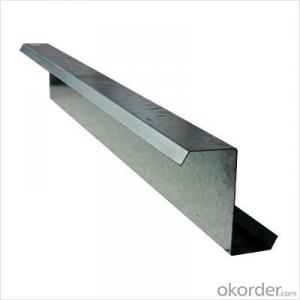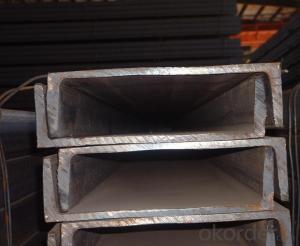CR C Channel
- Loading Port:
- Tianjin Port,China
- Payment Terms:
- TT or LC
- Min Order Qty:
- 20Tons m.t.
- Supply Capability:
- 1000 Tons Per Month m.t./month
OKorder Service Pledge
OKorder Financial Service
You Might Also Like
Specifications of CR C Channel:
1.We supply high quality CR C Channel at reasonable price, including Chinese standard, Japanese standard and so on.
Standard | GB/JIS/EN/ASTM/DIN |
Material Grade | Q235B,Q235,Q345,Q345B,SS400,S235JRG1,A36,ST37-2 |
Technique: | Cold Rolled |
Sizes as per chinese standard: |
80×40×20×2.5 - 180×60×20×2.5
|
Sizes as per Japanese standard: |
180×60×20×3 – 300×80×20×3 |
Length: | 6meter, 9meter, 12meter |
Note: we are also competent to provide our customers other CR C Channel based on other sizes according to customer’s requirements.
2. The detailed sections of CR C Channel as per GB standard.Just as followings in the table-1:
Size | Weight(kg/m) | Size | Weight(kg/m) |
80×40×20×2.5 | 3.925 | 180×60×20×3 | 8.007 |
80×40×20×3 | 4.71 | 180×70×20×2.5 | 7.065 |
100×50×20×2.5 | 4.71 | 180×70×20×3 | 8.478 |
100×50×20×3 | 5.652 | 200×50×20×2.5 | 6.673 |
120×50×20×2.5 | 5.103 | 200×50×20×3 | 8.007 |
120×50×20×3 | 6.123 | 200×60×20×2.5 | 7.065 |
120×60×20×2.5 | 5.495 | 200×60×20×3 | 8.478 |
120×60×20×3 | 6.594 | 200×70×20×2.5 | 7.458 |
120×70×20×2.5 | 5.888 | 200×70×20×3 | 8.949 |
120×70×20×3 | 7.065 | 220×60×20×2.5 | 7.4567 |
140×50×20×2.5 | 5.495 | 220×60×20×3 | 8.949 |
140×50×20×3 | 6.594 | 220×70×20×2.5 | 7.85 |
160×50×20×2.5 | 5.888 | 220×70×20×3 | 9.42 |
160×50×20×3 | 7.065 | 250×75×20×2.5 | 8.634 |
160×60×20×2.5 | 6.28 | 250×75×20×3 | 10.362 |
160×60×20×3 | 7.536 | 280×80×20×2.5 | 9.42 |
160×70×20×2.5 | 6.673 | 280×80×20×3 | 11.304 |
160×70×20×3 | 8.007 | 300×80×20×2.5 | 9.813 |
180×50×20×2.5 | 6.28 | 300×80×20×3 | 11.775 |
180×50×20×3 | 7.536 | ||
180×60×20×2.5 | 6.673 |
Table-1
3. The chemical composition of CR C Channel according to Q235B is shown in Table-2.
Alloy No | Grade | Element(%) | ||||
C | Mn | S | P | Si | ||
Q235 | B | 0.12-0.20 | 0.3-0.7 | ≦0.045 | ≦0.045 | ≦0.3 |
Table-2
Note: we are able to present our customers relevant SGS test report for chemical composition of CR C Channel.
4. The mechanical property of CR C Channel according to Q235B is shown in Table-3-1 and Table-3-2
Alloy No | Grade | Yielding Strength Point(Mpa) | |||
Thickness(mm) | |||||
≦16 | >16-40 | >40-60 | >60-100 | ||
≧ | |||||
Q235 | B | 235 | 225 | 215 | 205 |
Table-3-1
Alloy No | Grade | Tensile Strength(Mpa) | Elongation After Fracture(%) | |||
Thickness(mm) | ||||||
≦16 | >16-40 | >40-60 | >60-100 | |||
≧ | ||||||
G235 | B | 375-500 | 26 | 25 | 24 | 23 |
Table-3-2
Note: we are able to present our customers relevant SGS test report for mechanical property of CR C Channel as customer’s request.
Applications of CR C Channel:
The CR C Channel can be applied to construction of warehouses, workshops, sport stadiums and car parks etc.The hot rolled channel steel belongs to carbon structural steel which is applied to in the field of construction and machinery.In details, the hot rolled channel steel is usually used for arch-itechtural structure, and they could be welded in order to support or hang a vari-ety of facilities. They are also usually used in combination with I beam. Generally,the hot rolled channel steel we supply must possess perfect welding property, riveting property and mechanical property and so on.
Package & Delivery of CR C Channel:
1.The hot rolled channel steel will be packed in bundle with steel wire at each end of every bundle and color marking in order to help the customer to recognize his goods more easily at sight.
2. And the hot rolled channel steel could be loaded into 20ft or 40ft container, or by bulk cargo.If the weight of each bundle reaches more than 3.5 mt, the loading by break bulk cargo should be choosed.When the weight of each bundle reaches less than 3mt, the loading by container should be choosed.
3.As for the transportaion from mill to loading port, the truck will be usually used. And the maximum quantity for each truck is 40mt.
4.All in all, we could do in accordance with customer's request.

Production Flow of CR C Channel:
1.The steel billet shall be heated in the high temperature furnace.
2. The heated steel billet shall be rolled five to nine times with the aim of shaping the general figure of steel u channel.
3. The hot rolled channel steel should be put onto the cooling bed to make the temperature low.
4. The channel steel should be straighted on the straightener.
5. The straighted channel steel will be cut into meters by saw, as per customer's requirements.

- Q:What are the different surface coatings available for steel channels?
- There are several different surface coatings available for steel channels, each offering unique benefits and characteristics. Some of the most common surface coatings for steel channels include: 1. Galvanized Coating: This is one of the most widely used surface coatings for steel channels. Galvanized coating involves applying a layer of zinc to the surface of the steel channel through a process called hot-dip galvanizing. This coating provides excellent corrosion resistance, protecting the steel channel from rust and other environmental factors. 2. Powder Coating: Powder coating is a popular choice for steel channels that require a decorative and durable finish. In this process, a dry powder is applied to the surface of the steel channel and then heated to form a protective coating. Powder coating offers a wide range of colors and finishes, providing both aesthetic appeal and enhanced durability. 3. Epoxy Coating: Epoxy coatings are commonly used in industrial and commercial applications where resistance to chemicals, abrasion, and impact is required. These coatings are typically applied via a two-part epoxy system, which creates a strong and durable protective layer on the steel channel's surface. 4. Paint Coating: Paint coatings are a versatile option for steel channels, offering both protection and customization. Different types of paints, such as enamel, acrylic, or polyurethane, can be applied to the steel channel's surface to provide an attractive finish and protect it from corrosion and weathering. 5. Stainless Steel Coating: For applications that require exceptional resistance to corrosion and harsh environments, stainless steel coatings can be applied to steel channels. These coatings are typically composed of a high percentage of chromium, which forms a passive layer on the steel's surface, providing excellent protection against corrosion. 6. Polymer Coating: Polymer coatings are often used in industries where a non-stick or low-friction surface is required. These coatings, such as polytetrafluoroethylene (PTFE), provide a smooth and resistant surface that reduces wear and prevents the accumulation of debris or contaminants on the steel channel. It is important to consider the specific requirements and intended use of the steel channel when selecting a surface coating. Factors such as corrosion resistance, durability, aesthetics, and environmental conditions should be taken into account to ensure the appropriate coating is chosen for the steel channel.
- Q:Can steel channels be used in industrial buildings?
- Yes, steel channels can be used in industrial buildings. Steel channels are commonly used in industrial construction due to their strength, durability, and versatility. They are often used for structural support, framing, and as components in machinery and equipment. Steel channels provide a reliable and cost-effective solution for various applications in industrial buildings.
- Q:What are the different types of steel channel sections?
- In construction and engineering applications, various steel channel sections are commonly utilized. Some of the frequently used types are as follows: 1. C-channel: Employed for structural support and framing in construction projects, this steel channel features a C-shaped cross section. 2. U-channel: For applications demanding strength and rigidity, such as bridge and building construction, this steel channel with a U-shaped cross section is often chosen. 3. Hat channel: Also referred to as a furring channel, this steel channel has a hat-shaped cross section and is commonly used in the construction industry to attach drywall or other materials to walls and ceilings. 4. Z-channel: In scenarios where there is a need to join two pieces of material, like metal roofs or walls in construction, this steel channel with a Z-shaped cross section is commonly employed. 5. Box channel: This steel channel, with a square or rectangular cross section, is frequently used when a high strength-to-weight ratio is required, such as in the construction of bridges or support beams. These examples illustrate only a few of the available steel channel section types. The selection of the specific steel channel depends on the project's requirements and the desired strength and rigidity of the structure.
- Q:How do steel channels contribute to the overall sustainability certifications of a project?
- There are several ways in which steel channels contribute to the overall sustainability certifications of a project. Firstly, their high durability and long lifespan reduce the need for frequent replacements and repairs, thus saving resources and minimizing waste generation throughout the project's lifecycle. Furthermore, steel channels are often manufactured using recycled materials, which not only decreases the demand for virgin resources but also reduces the carbon footprint associated with their production. The use of recycled steel channels also helps divert waste from landfills, contributing to waste reduction goals and promoting a circular economy. Moreover, steel channels can be easily recycled at the end of their life, allowing for their reuse in other projects. This reduces the demand for new steel production and conserves energy and resources that would have been required for manufacturing new channels. Additionally, steel's strength and load-bearing capacity make it an excellent choice for structural applications, enabling the construction of more efficient and sustainable buildings. Steel channels can support larger spans and higher loads, allowing for the use of lighter and more sustainable building materials in other areas of the project. Lastly, steel channels can contribute to a project's sustainability certifications by facilitating the design and construction of energy-efficient structures. They can be integrated into innovative building systems, such as passive solar design or efficient HVAC systems, which can significantly reduce energy consumption and greenhouse gas emissions associated with the project. In conclusion, steel channels play a vital role in achieving the overall sustainability certifications of a project by providing durability, utilizing recycled materials, promoting recycling at the end of life, enabling efficient designs, and supporting energy-efficient construction practices.
- Q:How do steel channels contribute to the modular construction process?
- Steel channels play a crucial role in the modular construction process by providing structural support and stability. These channels are commonly used as framing elements in modular buildings, helping to create a strong and durable framework. They are also used to connect different modules together, ensuring a secure and seamless construction. Additionally, steel channels offer flexibility in design, allowing for easy customization and adaptation to different project requirements. Overall, steel channels significantly contribute to the efficiency, strength, and versatility of modular construction.
- Q:Can steel channels be used for solar panel racking systems?
- Yes, steel channels can be used for solar panel racking systems. They provide a strong and durable framework for mounting and securing solar panels, making them a popular choice in the industry. The versatility and structural integrity of steel channels make them suitable for supporting the weight of solar panels while withstanding various weather conditions.
- Q:What are the different methods for reinforcing steel channels against bending?
- There are various techniques available for strengthening steel channels against bending. 1. Additional steel plates can be utilized. One approach is to affix steel plates to both the upper and lower flanges of the channel. These plates can be welded or bolted to the existing flanges, thereby enhancing their strength and rigidity. This method is commonly employed when the channel is exposed to significant bending forces or when it needs to bear heavier loads. 2. Channel stiffeners can be employed. These are extra steel components that are attached either internally or externally to the channel to augment its strength and prevent bending. Usually, these stiffeners are welded or bolted to the flanges and web of the channel. They distribute the bending forces more evenly across the channel, thereby reducing the risk of failure. 3. Concrete reinforcement is another option. This involves reinforcing the steel channel with concrete. Typically, the channel is encased in a layer of concrete, which provides added strength and stiffness. The concrete can be poured around the channel or precast and subsequently attached to it. This method is commonly utilized in construction applications, such as bridges and buildings, where the channel needs to withstand high bending forces. 4. Composite materials can also be used for reinforcement. Materials like carbon fiber reinforced polymer (CFRP) can be employed to strengthen steel channels against bending. CFRP strips or sheets can be bonded to the flanges or web of the channel, delivering additional strength and rigidity. This method is lightweight and can be easily implemented in existing structures or during fabrication. It is important to consider various factors, including the magnitude of the bending forces, the specific application, and the available resources, when selecting a reinforcement method. Consulting with a structural engineer or an industry professional is advisable to determine the most suitable approach for a particular project.
- Q:How do steel channels contribute to the sustainability of a building?
- Steel channels contribute to the sustainability of a building in several ways. Firstly, they are highly durable and have a long lifespan, reducing the need for frequent replacements or repairs. This minimizes the overall environmental impact associated with the production and disposal of building materials. Additionally, steel channels can be easily recycled at the end of their life cycle, reducing waste and conserving natural resources. Furthermore, steel channels are lightweight, allowing for more efficient transportation and installation, which reduces energy consumption during construction. Lastly, steel channels provide structural strength and support, allowing for the design of more sustainable and space-efficient buildings.
- Q:What are the different surface treatments available for steel channels in corrosive environments?
- Steel channels in corrosive environments can be protected using various surface treatments. These treatments aim to create a protective layer on the steel surface, preventing corrosion and prolonging the lifespan of the channels. One commonly employed treatment is hot-dip galvanizing. This method involves immersing the steel channels in molten zinc, resulting in the formation of a zinc-iron alloy coating. This coating acts as a barrier against corrosive elements, effectively safeguarding the steel from rust and corrosion. Another alternative is electroplating, which entails depositing a thin layer of metal onto the steel channels through an electrochemical process. Zinc, nickel, and chromium are frequently used for electroplating. Each metal offers distinct corrosion resistance properties, and the choice of electroplating material depends on the specific corrosive environment. Moreover, organic coatings such as paints or powder coatings can be applied to steel channels. These coatings create a protective layer over the steel, acting as a barrier against moisture and corrosive chemicals. Paints can be applied through spraying, brushing, or dipping, while powder coatings involve applying a dry powder that is then heated to form a protective coating. In certain cases, steel channels can undergo passivation. This process employs acid solutions to eliminate surface impurities and generate a protective oxide layer on the steel surface. This oxide layer enhances the steel's resistance to corrosion. When selecting a surface treatment for steel channels, it is crucial to consider the specific corrosive environment and the desired level of protection. Seeking advice from corrosion experts or professionals in the steel industry can aid in determining the most suitable treatment option for a particular application.
- Q:How do steel channels compare to I-beams?
- Steel channels and I-beams are both structural steel shapes that are commonly used in construction and engineering applications. While they have some similarities, they also have distinct differences. One key difference between steel channels and I-beams is their shape. Steel channels have a C-shaped cross-section, with two flanges on either side and a web connecting them. This design provides good structural support and resistance against bending. On the other hand, I-beams have an I-shaped cross-section, with two flanges and a central web. This design distributes the load evenly across the beam's top and bottom flanges, making it highly efficient for carrying heavy loads and resisting bending and deflection. Another difference is their weight-bearing capacity. I-beams are known for their high strength-to-weight ratio, making them capable of carrying larger loads over longer spans. Steel channels, while still strong, are typically used for lighter applications or as secondary structural components. Cost can also be a factor when comparing steel channels and I-beams. Generally, steel channels tend to be more cost-effective compared to I-beams due to their simpler manufacturing process and smaller size. However, the specific cost will depend on the size, length, and quality of the materials. In terms of versatility, both steel channels and I-beams offer a wide range of applications. Steel channels are commonly used for framing, support structures, and bracing in construction projects. They can also be used as lintels or purlins. I-beams, on the other hand, are widely used in the construction of bridges, buildings, and large-scale infrastructure projects where heavy loads and long spans are required. In conclusion, steel channels and I-beams have different shapes, weight-bearing capacities, costs, and applications. Steel channels are typically more cost-effective and suitable for lighter applications, while I-beams offer superior strength and are better suited for heavy loads and longer spans. Choosing between the two will depend on the specific requirements of the project and the desired balance between strength, cost, and design.
1. Manufacturer Overview |
|
|---|---|
| Location | Tianjin, China |
| Year Established | 2007 |
| Annual Output Value | Above US$ 15 Million |
| Main Markets | Southeast Asia; Africa |
| Company Certifications | |
2. Manufacturer Certificates |
|
|---|---|
| a) Certification Name | |
| Range | |
| Reference | |
| Validity Period | |
3. Manufacturer Capability |
|
|---|---|
| a)Trade Capacity | |
| Nearest Port | Tianjin |
| Export Percentage | 15%-20% |
| No.of Employees in Trade Department | 11-20 People |
| Language Spoken: | English; Chinese; |
| b)Factory Information | |
| Factory Size: | Above 6,500 square meters |
| No. of Production Lines | 1 |
| Contract Manufacturing | OEM service offered |
| Product Price Range | average |
Send your message to us
CR C Channel
- Loading Port:
- Tianjin Port,China
- Payment Terms:
- TT or LC
- Min Order Qty:
- 20Tons m.t.
- Supply Capability:
- 1000 Tons Per Month m.t./month
OKorder Service Pledge
OKorder Financial Service
Similar products
New products
Hot products
Hot Searches
Related keywords
